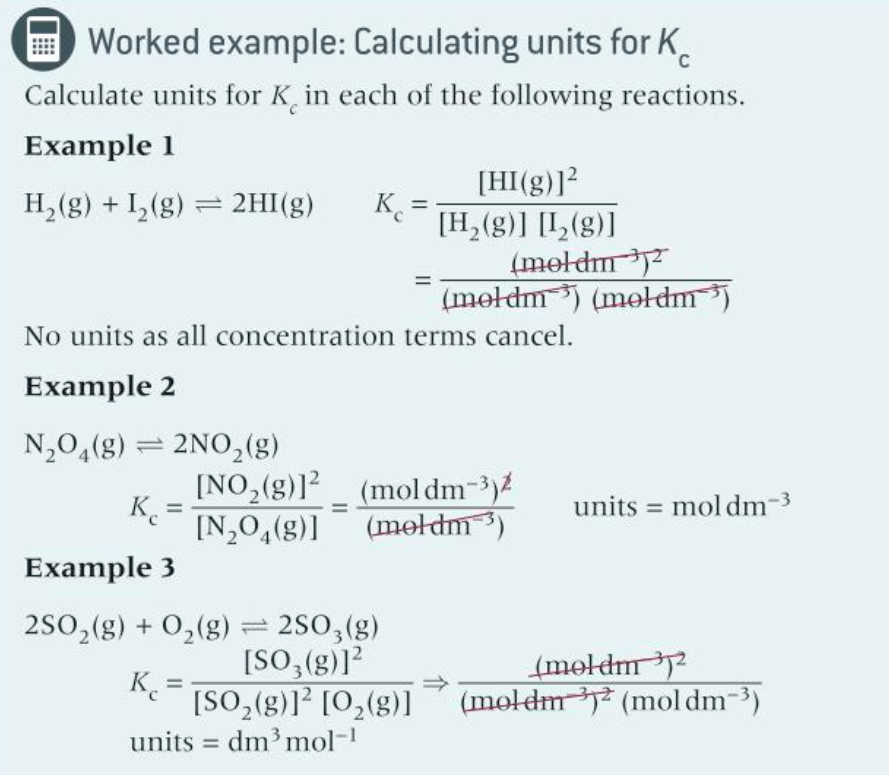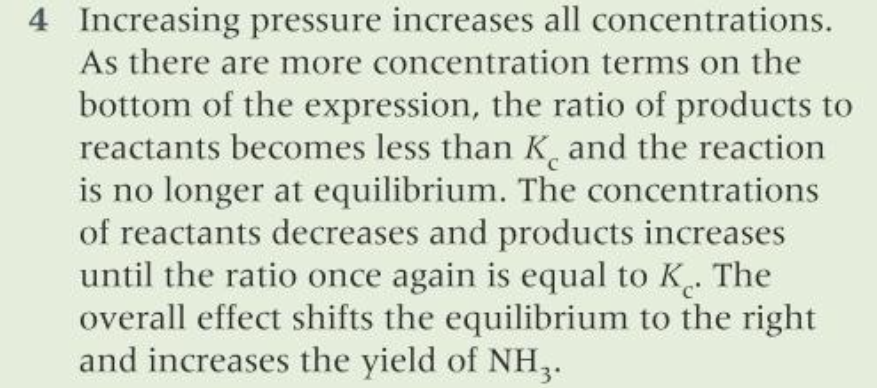19 Equilibrium
1/26
There's no tags or description
Looks like no tags are added yet.
Name | Mastery | Learn | Test | Matching | Spaced |
|---|
No study sessions yet.
27 Terms
expression for Kc in N2(g) + 3H2(g) ⇌ 2NH3(g)
Kc = [NH3(g)]2 / [N2(g)] [H2(g)]3
how to work out units of Kc

What are the two main types of equilibria
homogeneous and heterogeneous
def homogeneous equilibria
A homogenous equilibrium contains equilibrium species that all have the same state or phase. e.g. an equilibrium is homogenous if all the equilibrium species have the same state and are gases.
e.g. N2(g) + 3H2(g) ⇌ 2NH3(g)
def heterogeneous equilibrium
A heterogeneous equilibrium contains equilibrium species that have different states or phases.
e.g. C(s) + H2O(g) ⇌ CO(g) + H2(g)
Any species that are solids and liquids are omitted from the Kc expression, they’re automatically incorporated within the overall equilibrium constant. Kc only includes species that are (g) or (aq).
what is the Kc expression for C(s) + H2O(g) ⇌ CO(g) + H2(g)
Kc = [CO(g)] (H2(g)] / [H2O(g)]
the method for calculating Kc from equilibrium amounts
make a table of the elements across the top then ‘ratio of n’, ‘initial n’, ‘change’ and ‘eqm n’ down the side
calculate [] elements
sub into Kc equation
how are equilibria involving gases usually expressed
Kp
what is the relationship between Kp and Kc
Concentration and pressure are proportional to each other and Kp and Kc have a direct relationship to ecah other
equation of a mole fraction of a gas A
mole fraction x(A) = (number of moles of A) / (total number of moles in gas mixture
what is the partial pressure p in a gas mixture
in a gas mixture, the partial pressure p of a gas is the contribution that the gas makes towards the total pressure P. The sum of the partial pressures of each gas equals the total pressure.
For gas A in a gas mixture:
partial pressure p(A) = mole fraction of A x total pressure P
p(A) - x(A) x P
the equilibrium constant
Kp
the Kp for H2(g) + I2(g) ⇌ 2HI(g)
Kp = p(HI)2 / p(H2) x p(I2)
p is the equilibrium partial pressure
Kp only includes gases because only gases have partial pressures, any other species must be ignored.
suitable units for partial pressures?
kPa or Pa or atm but same unit must be used for all gases
3 rules of le chatelier’s principle
if the concentration of a species is increased, the equilibrium shifts in the direction that reduces the concentration
if the pressure is increased, the equilibrium position shifts towards the side with fewer gaseous moles
if the temperature is increased, the equilibrium position shifts in the endothermic direction
why does le chatelier’s principle work? (2 words)
equilibrium constants
what does the value of K indicate
the exact position of an equilibrium
K = 1 indicates an eqm halfway between reactants and products
K = 100 indicates an eqm well in favour of the products
K = 1 × 10-2 indicates an eqm well in favour of the products
when the reactants or products of a reversible reaction are mixed together, the rxn proceeds until the []s of the eqm species give the value of K when placed in the eqm constant expression.
At a set temperature, K is constant and doesn’t change despite any modifications to [], pressure, or the presence of a catalyst.
what is the only condition that will cause K to change its value
temperature
whether the value of K gets larger or smaller depends on whether the forward rxn is exothermic of endothermic
how is K affected if the forward rxn is exothermic w increasing temp
the equilibrium constant decreases with increasing temperature
raising the temperature decreases the equilibrium yield of products

explain the eqm shift when the forward rxn is exothermic w increasing temp
if the temp increases:
Kp decreases
system no longer in eqm
the partial pressures of the product must DECREASE
so the partial pressures of the reactants must INCREASE
position of eqm shifts towards the reactants (LHS)
so the ratio Kp = p(products) / p(reactants changes
how is K affected if the forward rxn is endothermic w increasing temp
the eqm constant increases w increasing temperature
raising the temp increases the eqm yield of products
explain the eqm shift when the forward rxn is endothermic w increasing temp
if the temp increases:
Kp increases
system no longer in eqm
the partial pressure of the product must increase
the partial pressures of the reactants must decrease
position of eqm shifts to the products (RHS)
so the ratio Kp = p(products) / p(reactants changes
how does a catalyst affect eqm constants
eqm constants are unaffected by the presence of a catalyst
catalysts affect the rate of a chemical reaction but not the position of eqm
they speed up both the forward and reverse rxns by the same factor
how do changes in [] and pressure affect equilibrium constants
the value of an eqm constant is unaffected by changes in [] or pressure.
the shift in eqm position learnt from le chatelier’s principle is a result from the fact the eqm constant doesn’t change.
explain the shift in eqm if concentration increases
if concentration of N2O4(g) increases
the ratio of Kc changes, system no longer in eqm
the concentrations must change to return the ratio back to the Kc value
so the [product] must INCREASE
and the [reactant] must decrease
![<p>if concentration of N<sub>2</sub>O<sub>4(g)</sub> increases</p><ul><li><p>the ratio of K<sub>c</sub> changes, system no longer in eqm</p></li><li><p>the concentrations must change to return the ratio back to the K<sub>c </sub>value</p></li><li><p>so the [product] must INCREASE</p></li><li><p>and the [reactant] must decrease</p></li></ul><p></p>](https://knowt-user-attachments.s3.amazonaws.com/5c5e1c62-fe51-47b6-97e2-ccac50c88571.png)



Explain what would you see if more C were added at room temp? (3 marks)
